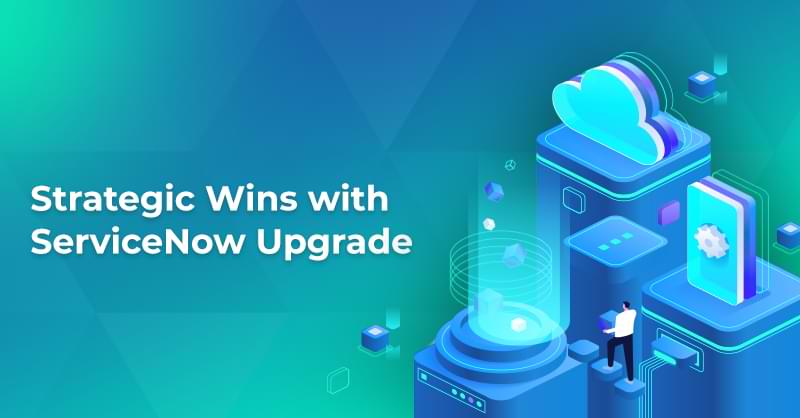Strategic Wins with ServiceNow Upgrade

Written by Harini Krish
Sr Content Lead
September 28, 2022
With every upgrade, ServiceNow brings in a new application with incredible features, performance improvement, and bug fixes, and it follows the cycle of two releases per year. To utilize these capabilities, you must upgrade your ServiceNow platform to the new release, so you don’t get left behind. After all, ServiceNow provides technical support only to the latest and the release before the latest. Failure to upgrade your instance can lead to performance and security issues.
ServiceNow platform upgrades could be a nightmare for clients if not planned, executed, and finished within a specific duration. And if the upgrade is not finished within a short duration, it can impact the delivery of other ongoing projects. Failure in project delivery can impact businesses in every aspect, be it a monetary or reputational loss. Currently, upgrades are managed by ‘Update Sets,’ which creates many challenges in migrating code between the different instances and coordination between the developers.
As part of the Tokyo release, ServiceNow brings the feature of “Upgrade Plan,” which reduces the overall upgrade time and helps in the planning and execution of upgrades in a better way. It also eliminates the dependency on managing update sets which is the pain area for developers. This blog will discuss the ‘Upgrade Plan’ feature in detail.
An Overview of the ServiceNow Upgrade Plan
There are several advantages when using the ServiceNow ‘Upgrade Plan’ feature:
- Upgrade Plan accelerates your Upgrade by packaging your skip records and customizations into the appropriate application container (global apps or app customizations).
- Upgrade Plan helps you define applications and target versions to be installed in your instance.
- It automates the installation of applications during upgrades, giving you a seamless upgrade experience.
Before you utilize the Upgrade Plan functionality, you must identify your builder and consumer instances. Usually, the builder instance will be the developer instance, and the consumer instance will be the upper environments (Test, UAT, Preproduction, Production, etc.). Instance type is decided by the system property “glide.upgrade.plan.instance_type”; you must configure the property either as a builder or a consumer. Once you have identified the builder instance, you can mark other instances as consumer instances.
Build your Upgrade Plan in Builder Instance:
Before you start working on an upgrade, make sure that your builder instance is upgraded to the latest release. After upgrading to the latest version, you will see some skipped records. Some of those records will already be marked as “reviewed,” and some will “need to be reviewed.” Review your customization and resolve them (all the items which come under “Skipped Changes to Review” in Upgrade). With Upgrade Plan, you don’t need to capture resolved items in any update set. Once you think that the current behavior of the builder environment is sufficient to proceed, go to Upgrade Plan. We have provided the precise steps as seen on the platform:
Navigate to All > Upgrade Center > Upgrade Plan.
It will open the list of the upgrade plan. Then, on the top right-hand side, you will see a “Build” button, click on it to create a plan for upgradation, then comes the pop-up for confirmation. Once confirmed, it picks the current upgrade history record, collects all skipped records, and groups them into different scopes to which they belong. Then it creates customization packs for all the customization records and finally creates an upgrade plan. Once the build is completed, you will see two options in the success pop-up window:
- View Details: Review all the details by clicking on “View Details” it gives a brief picture of the application which got picked or if any of them have any conflict error during the ‘Build’ execution process. After reviewing, you can go to the upgraded plan.
OR
- Go to Upgrade Plan: Directly proceed with upgrading and get all the latest upgrade details.
Upgrade Plan has a related list of all the items included. After creating an upgrade plan, if you resolve more customization, click on the “Refresh” button to capture it in Upgrade Plan. The “Refresh” button can be found within the ‘Upgrade Plan’ record.
You can publish the plan to the repository with the “Publish” button in the Upgrade Plan record. Once you click it, it creates a new global application with the package (including all resolved customization and skipped records). In addition, you will notice that the “Application” column of the Upgrade Plan record gets populated with some value. This is the application’s name that gets published into the app repository, and the same application will be retrieved in the consumer instance.
How to Retrieve the Upgrade Plan in Consumer Instance:
To access the upgrade plan within the consumer instance:
- Go to the consumer instance and open the upgrade plan,
- You will see on the upgrade plan ‘list view’ a “Retrieve” button; click on this button, and it will take you to “My Company Application View.”
- Now search for the application published after building the plan and install it in the consumer instance.
- The upgrade plan needs to be installed in the consumer instance before upgrading the application to a new release.
- After installation, go to the Upgrade Plan “list view,” where you can search and open your plan. You must ensure all the upgrade items’ states are “Ready” before starting the Upgrade.
- Now go to “Upgrade Preview” to verify if the consumer environment has any item to review as mentioned under the “Predicted skipped records with upgrade plan” card.
- You can review them, and if they need to be resolved, go to your builder instance and resolve them and again create an upgrade plan and follow the same steps. Otherwise, the item highlighted for review in the “Upgrade Preview” will be reverted to ‘out of the box.
You can kick off the upgrade in your consumer instance, and the upgrade engine will automatically pick the items from the upgrade plan. Once the upgrade is done, the instance is ready to be used. You don’t have to resolve/skip/review any item.
ServiceNow Upgrade Plan: Pros and Cons
There are several benefits of using the “Upgrade Plan” feature over the traditional upgrade approach:
- Upgrade Plan makes upgrade execution robust.
- It removes the dependency on the update set and the coordination between developers to apply changes after upgrades.
- With this approach, upgrades can be done within a couple of weeks, depending on the environment’s customization.
- Upgrade Plan can be used for hotfixes.
However, there is one limitation: This feature is only available from the ServiceNow Tokyo release onwards. Thus, you can’t use this function if you want to upgrade your instance from San Diego to Tokyo.
How Royal Cyber Can Help
Implementing ServiceNow solutions successfully is a task that is easier said than done. Companies need the right expertise to ensure cost-effective and high-performing digital transformation services. This is the issue where the Royal Cyber ServiceNow practice team can help. With our certified ServiceNow experts who have over a decade’s worth of experience in the business. Our certified specialists offer ServiceNow implementation, consultancy, integration, service orchestration, managed services, stakeholder communication, training, customization, testing, and support services to clients worldwide. Let’s discuss your Upgrade Needs. To learn more about Royal Cyber, visit our website at www.royalcyber.com or send your queries to [email protected].
Recent Blogs
- An Insight into ServiceNow Hardware Asset Management (HAM) Ramya Priya Balasubramanian Practice Head ServiceNow Gain …Read More »
- Learn to write effective test cases. Master best practices, templates, and tips to enhance software …Read More »
- In today’s fast-paced digital landscape, seamless data integration is crucial for businessRead More »





